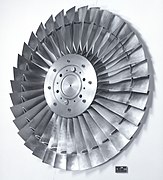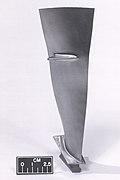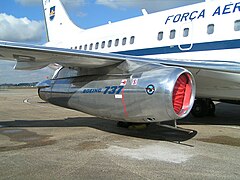Pratt & Whitney JT8D
| JT8D | |
|---|---|

| |
| The JT8D is alow-bypassturbofanoften used on early narrowbodyjetliners | |
| Type | Turbofan |
| National origin | United States |
| Manufacturer | Pratt & Whitney |
| First run | 1960 |
| Major applications | Boeing 727 Boeing 737-100/-200 McDonnell Douglas DC-9 McDonnell Douglas MD-80 Dassault Mercure |
| Number built | 14,750[1] |
| Developed from | Pratt & Whitney J52 |
| Developed into | Volvo RM8 |
ThePratt & Whitney JT8Dis alow-bypass(0.96 to 1)turbofanengine introduced byPratt & Whitneyin February 1963 with the inaugural flight of theBoeing 727.It was a modification of thePratt & Whitney J52turbojetengine which powered theUS NavyA-6 IntruderandA-4 Skyhawkattack aircraft.Eight models comprise the JT8D standard engine family, covering the thrust range from 12,250 to 17,400pounds-force(54 to 77 kN), and power the727,737-100/200,andDC-9.The updated JT8D-200 family, covering the 18,900 to 21,000pounds-force(84 to 93 kN), powers theMD-80and re-enginedSuper 27aircraft. The JT8D was built under license in Sweden as theVolvo RM8,a redesigned afterburning derivative for theSaab 37 Viggenfighter.[2]Pratt & Whitney also sells static versions for powerplant and ship propulsion as theFT8.
Design
[edit]
This sectionneeds additional citations forverification.(October 2008) |
The JT8D is an axial-flow front turbofan engine incorporating atwo-spooldesign. There are two coaxially-mounted independent rotating assemblies: one rotating assembly for the low pressure compressor (LPC) which consists of the first six stages (i.e. six pairs of rotating and stator blades, including the first two stages which are for the bypass turbofan), driven by the second (downstream) turbine (which consists of three stages); and a second rotating assembly for the high-pressure compressor (HPC) section, which has seven stages. The high-pressure compressor is driven by the first (upstream) turbine, which has a single stage.
The front-mounted bypass fan has two stages. The annular discharge duct for the bypass fan runs along the full length of the engine, so that both the fan air and exhaust gases can exit through the same nozzle. This arrangement allows some noise attenuation, in that the still-hot fast-moving turbine exhaust is shrouded in much-cooler and slower-moving air (from the bypass fan) before interacting with ambient air. Thus, the JT8D noise levels were significantly reduced from previous non-turbofan engines, although the lowbypass ratiomeant that, compared to subsequently developed turbofans, high noise levels were still produced.
Within the fan inlet case, there areanti-icingair bosses and probes to sense the inlet pressure and temperature. Similar units exist throughout the engine to check temperatures and pressures.
At the 13th (i.e. the final) compressor stage, air is bled out and used for anti-icing. The amount is controlled by the Pressure Ratio Bleed Control sense signal (PRBC). Thediffuser caseat the aft end of the compressor houses the 13th stage. Its increasing cross-sectional area allows the compressed air to slow down before entering one of the engine's nine burner cans. Again, there are two bosses to extract 13th stage air for anti-icing, de-icing of fuel, and airframe (cabin pressurization) use. Not all the compressed air enters the burner cans at the fuel-ignition point; some bypasses the can completely and cools the first turbine stage, and some is gradually introduced into the burner can's perimeter in such a way that the burning fuel is held near the can's centerline.
There are nine combustion chambers positioned in a can-annular arrangement. Each chamber has three air inlet hole sizes: the smallest is for cooling, the medium is for burning and the largest for forming an air blanket.
- Details
-
Cannularcombustor
-
20 in (510 mm) diameter rotor and bypass stator
-
Compressor fan
-
Fan blade
Update programs
[edit]
In response to environmental concerns that began in the 1970s, the company began developing a new version of the engine, the JT8D-200 series.[3]Designed to be quieter, cleaner, more efficient, yet more powerful than earlier models, the -200 Series power-plant was re-engineered with a significantly higherbypass ratio(1.74 to 1) covering the 18,500 to 21,700 pound-force (82 to 97 kN) thrust range and powering theMcDonnell Douglas MD-80 series.This increase was achieved by increasing bypass fan diameter from 39.9 inches (101 cm) to 49.2 inches (125 cm) and reducing fan pressure ratio (from 2.21 to 1.92).[citation needed]Overall engine pressure ratio was also increased from 15.4 to 21.0.[4]Since entering service in 1980, more than 2,900 of the -200 series engines have been produced.
The JT8D-217 and -219 engine(s) were tested in 2001 and were deemed suitable replacements for the oldTF33engines on military and commercial aircraft as part of the Super 27 re-engining program. The updated engines offer reduced (Stage-3) noise compliance standards without the need for hush kits, enhanced short field performance, and steeper and faster climb rates with roughly a 10% reduction in fuel burn for extended range.
Pratt & Whitney, in a joint venture with Seven Q Seven (SQS) and Omega Air, developed the JT8D-219 as a re-engine powerplant forBoeing 707-based aircraft.[5]Northrop Grumman used the -219 to re-engine one of the United States Air Force's fleet of 19 Joint Surveillance Target Attack Radar System (E-8 Joint STARS) aircraft, which would allow the JSTARS more time on station due to the engine's 17%[6]greater fuel efficiency. However these plans were cancelled after the single conversion when the decision was taken to retire the platform. NATO originally planned to re-engine their fleet ofE-3 SentryAWACS aircraft, however again this was cancelled after the decision was taken to retire the E-3 platform in preference for the E-7 Wedgetail. The -219 is publicized as being half the cost of the competing 707 re-engine powerplant, theCFM International CFM56,for reasons of geometrical and balance similarity to the engine it is replacing and the associated relative up-front wing modification costs of the two choices.[5][6]
The proposedAerion SBJsupersonic business jet,previously under development, was to use a pair of JT8D-219 engines for sustainedsupersonicflight.
Variants
[edit]
| Series | Initial J52 derived variants[7] | Updated -200 series[8] | |||||
|---|---|---|---|---|---|---|---|
| Model | -1(A/B)/7(A/B) /9(A)/11 |
-5 | -15(A) | -17(A/R/AR) | -209 | -217(A/C) | -219 |
| Certification | Feb 1, 1963 | Apr 7, 1971 | Feb 1, 1974 | Jun 22, 1979 | Oct 31, 1980 | Feb 22, 1985 | |
| Compressor | axial 13-stage | axial 14-stage | |||||
| Combustors,turbine | 9 can-annular, 4-stage | ||||||
| Maximum Thrust | 14,000–15,000 lbf 62–67 kN |
12,250 lbf 54.5 kN |
15,550 lbf 69.2 kN |
17,000–17,400 lbf 76–77 kN |
18,900 lbf 84 kN |
20,000 lbf 89 kN |
21,000 lbf 93 kN |
| Length | 123.56 in (3,138 mm) | 154.20 in (3,917 mm) | |||||
| Width | 40.0 in (1,020 mm) | 49.2 in (1,250 mm) | |||||
| Dry Weight | 3,205–3,402 lb 1,454–1,543 kg |
3,205 lb 1,454 kg |
3,414–3,474 lb 1,549–1,576 kg |
3,430–3,500 lb 1,560–1,590 kg |
4,588 lb 2,081 kg |
4,623–4,684 lb 2,097–2,125 kg |
4,684 lb 2,125 kg |
| LP rpm | 8,600 | 8,500 | 8,800 | 8,800-8,900 | 7,850 | 7,770-8,080 | 8,120 |
| HP rpm | 12,250 | 12,100 | 12,250 | 12,250-12,280 | 12,150 | 12,285-12,350 | 12,350 |
Production
[edit]More than 14,000 JT8D engines have been produced, totaling more than one-half billion hours of service, with more than 350 operators, making it the most popular of all low-bypass turbofan engines ever produced.[9][1]Regular production ended in 1985, but some replacement engines were produced for military aircraft in 2011.[10]Mainline airlineuse of the JT8D continued until 2020 whenDelta Air Linesretired theirMD-88fleet early due to theCOVID-19 pandemic.[11]
Applications
[edit]- Aerion SBJ– proposed, not built
- Boeing 707RE
- Boeing 727- Re-Engined Super 27s have JT8D-200s
- Boeing 737-100/-200
- Dassault Mercure
- Kawasaki C-1
- McDonnell Douglas DC-9
- McDonnell Douglas MD-80series - JT8D-200s only
- McDonnell Douglas YC-15
- Northrop Grumman E-8C Joint STARS– single testbed only
- Sud Aviation Caravelle10B, 10R, 11R, and 12
- Pratt & Whitney FT8 MobilePac and SwiftPac mobile generators[12]
- Installations
Accidents
[edit]- 18 January 1969
- United Airlines Flight 266– ten minutes after takeoff, the cockpit received a warning from Engine 1 of an engine fire and cut off power to that engine. A minute later, Flight UA266 suffered a total loss of electrical power, which disabled the aircraft's flight instruments. At 13 minutes after take-off, the plane crashed into the Pacific Ocean, just 12 miles off the coast, killing all 38 people aboard the aircraft, which consisted of 32 passengers and six crew members.
- 4 April 1977
- Southern Airways Flight 242– both engines on theDC-9failed when the pilots flew into a severe thunderstorm after misreading their onboard radar. The flight encountered severe rain and hail. The NTSB concluded that the "loss of thrust was caused by the ingestion of massive amounts of water and hail which in combination with thrust lever movement induced severe stalling in and major damage to the engine compressors". Some 63 people on board and nine on the ground died as a result of the accident.
- 22 August 1985
- British Airtours Flight 28M– an engine failed during take-off fromManchester Airportand a fire spread into the cabin, resulting in 55 fatalities aboard theBoeing 737-236 Advanced.
- 6 September 1985
- Midwest Express Flight 105– the NTSB concluded that an unconfined failure of the 9th - 10th stage compressor spacer occurred immediately after takeoff fromMilwaukee Mitchell International Airport(then called Billy Mitchell Field). The plane was observed to have slowed significantly as a result of the engine loss and experienced an accelerated stall condition. The plane rolled to the right 90 degrees and crashed just south of the runway, resulting in 31 fatalities (all passengers and crew) aboard the McDonnell-Douglas DC-9 aircraft.[13]
- 3 May 1991
- Ryan Airlines– unconfined failure of 9th stage compressor disc penetrated fuel lines and fuselage on the tarmac atBradley International Airportcausing fire and complete loss of aircraft. No fatalities reported.[14]
- 27 December 1991
- Scandinavian Airlines Flight 751– the engines on an MD-81 ingested wing ice during takeoff causing engine damage that led to a total loss of thrust on both engines. The aircraft crashed in a forest clearing with no fatalities.
- 6 July 1996
- An engine explosion happened on anMD-88,Delta Air Lines Flight 1288,just prior to take-off atPensacola, Florida,USA, with two fatalities.
- 6 March 2003
- A737-200operated byAir Algériecrasheddue to sudden loss of thrust as a result of the left engine's fan blades fracturing and the captain taking controls off of the first officer without assessing or mentally preparing for the situation. All six crew and 96 of the 97 passengers were killed.
- 15 April 2008
- ADC-9-51operated byHewa Bora Airwayscrashedand burned atGomafollowing an engine fire, with 40 fatalities.
- 10 July 2019
- AMcDonnell Douglas MD-88operated byDeltalanded safely after an engine failure.[15]
- 2 July 2021
- Transair Flight 810– one engine on theBoeing 737-200cargo aircraft failed en route fromHonoluluto the neighboring Hawaiian island ofMaui.The crew attempted to turn back to Honolulu'sDaniel K. Inouye International Airport,but the plane's second engine overheated, forcing the two pilots on board toditchthe airplane about 4 miles (6.4 km) off the southern coast ofOahu.Both pilots were rescued by theUnited States Coast Guard.[16]
- 19 October 2021
- A privately owned MD-87 was recorded on its takeoff roll just after throttling up a "puff of smoke" was observed from the left engine nacelle. Subsequently the aircraft rolled off the end of the runway into a grass field and caught fire. The MD-87 was almost completely destroyed by the resulting fire.[17]The privately owned jet, N987AK McDonnell Douglas MD-87, owned by J. Alan Kent Development LLC,[18]was operating a charter flight carrying sports fans to Boston for the ALCS Championship Baseball Games. Only 1 minor injury and no fatalities occurred in this incident.[19]It is still under active investigation.
Specifications (JT8D-219)
[edit]General characteristics
- Type:Dual-spool,low-bypass turbofan
- Length:154 in (390 cm)
- Diameter:49.2 in (125 cm) fan
- Dry weight:4,741 lb (2,150 kg)
Components
- Compressor:Axial flow,1-stage fan, 6-stage LP, 7-stage HP
- Combustors:Ninecan-annular( "cannular" ) chambers
- Turbine:1 stage HP, 3 stage LP
Performance
- Maximumthrust:21,000lbf(93kN)
- Overall pressure ratio:19.4
- Air mass flow:144.7 kg/s (19,140 lb/min) for -9, 211.83 kg/s (28,020 lb/min) for -109
- Fuel consumption:19% reduction overJT3D
- Specific fuel consumption:22.661 g/(kN⋅s) (0.8000 lb/(lbf⋅h))
- Thrust-to-weight ratio:4.43
See also
[edit]Related development
Comparable engines
Related lists
References
[edit]- ^ab"JT8D".Pratt and Whitney.Archivedfrom the original on 2022-01-25.Retrieved2021-07-07.
The JT8D engine has proven itself to be a highly durable and reliable engine, having completed more than 673 million dependable flying hours since entering service. Once deemed the workhorse of the industry, more than 14,750 JT8D engines have flown. Today, there are 2,400 engines still in use.
- ^Gunston, p. 236
- ^Gunston, Bill (1999).The Development of Piston Aero Engines, 2nd Edition.Sparkford, Somerset, England, UK: Patrick Stephens, Haynes Publishing. p. 169.ISBN0-7509-4478-1.
- ^"Pratt & Whitney website, accessed 14 October 2007".Archivedfrom the original on 5 July 2008.Retrieved29 March2009.
- ^abFlug Revue,May 12, 2002ArchivedNovember 7, 2007, at theWayback Machine
- ^ab"Re-engining the E-8 JSTARS,May 14, 2008 ".Archivedfrom the original on September 24, 2016.RetrievedJune 23,2009.
- ^"Type Certificate E2EA data sheet"(PDF).Federal Aviation Administration. August 28, 2007.Archived(PDF)from the original on December 28, 2016.RetrievedDecember 23,2020.
- ^"Type Certificate E9NE data sheet"(PDF).Federal Aviation Administration. December 13, 2010.Archived(PDF)from the original on April 19, 2021.RetrievedDecember 23,2020.
- ^"Pratt & Whitney's JT8D Engine Turns Half a Century Old".MediaRoom.Pratt and Whitney.Archivedfrom the original on 2021-07-09.Retrieved2021-07-07.
More than 14,750 JT8D engines have been built, accumulating more than half a billion hours of service. At one point, JT8D engine sales and service contributed about half of United Technologies' profits. Today, it continues to generate revenue through overhauls, spare parts sales and kits to make it quieter and cleaner burning.
- ^Lee, Mara (2011-03-03)."JT8D Engine Revived At Pratt & Whitney".Hartford Courant.Archivedfrom the original on 2021-07-08.Retrieved2021-07-07.
- ^McMurtry, Ian (2020-06-03)."The JT8D Engine Roars into History Books as Delta Retires McDonnell Douglas Fleet".AirlineGeeks.com.Archivedfrom the original on 2021-07-09.Retrieved2021-07-08.
- ^"Pratt & Whitney Celebrates Completion of 50th FT8 MobilePac Power Generator: Hartford Courant, July 18, 2011".Archivedfrom the original on 2015-11-22.Retrieved2015-11-22.
- ^https://www.ntsb.gov/investigations/AccidentReports/Reports/AAR8701.pdfArchived2020-10-16 at theWayback Machine| NTSB Aircraft Accident Report AAR8701
- ^"ASN Aircraft accident Boeing 727-22QC N425EX Hartford-Bradley International Airport, CT (BDL)".Aviation Safety Network.Archivedfrom the original on 2010-06-15.Retrieved2015-12-26.
- ^"A Delta flight was forced to make an emergency landing when one of the plane's engines failed".CNN.10 July 2019.Archivedfrom the original on 8 November 2020.Retrieved10 July2019.
- ^Shapiro, Emily; Stone, Alex (July 2, 2021)."2 pilots alive after plane crashes few miles off coast of Hawaii".ABC News.Archivedfrom the original on 2021-07-09.Retrieved2021-07-02.
- ^"Video shows MD-87 plane taxis down runway before fiery crash near Houston".YouTube.20 October 2021.Archivedfrom the original on 2021-10-30.Retrieved2021-10-22.
- ^"J. Alan Kent".Archivedfrom the original on 2021-10-22.Retrieved2021-10-22.
- ^"ASN Aircraft accident McDonnell Douglas MD-87 N987AK Houston Executive Airport, TX".Archivedfrom the original on 2021-10-21.Retrieved2021-10-22.
- ^"JT8D-219Turbofan Engine"(PDF).Pratt & Whitney. September 2010. Archived fromthe original(PDF)on 2017-05-10.Retrieved2016-08-25.
- ^"JT8D-200 Turbofan Engine".MTU Aero Engines.Retrieved2024-02-13.
- ^"PHASE I - FINAL REPORT a JT8D-100 TURBOFAN ENGINE"(PDF).NASA. June 1974.Retrieved2024-02-13.
- ^"Integration of turbofan engines into the preliminary design of a high-capacity short-and medium-haul passenger aircraft and fuel efficiency analysis with a further developed parametric aircraft design software"(PDF).Lehrstuhl für Luftfahrtsysteme Technische Universität München. 28 May 2015.Retrieved2024-02-13.
- Gunston, Bill (1999).The Development of Piston Aero Engines, 2nd Edition.Sparkford, Somerset, England, UK: Patrick Stephens, Haynes Publishing.ISBN0-7509-4478-1.
External links
[edit]- Pratt & Whitney - JT8D pageArchived2019-09-01 at theWayback Machine
| Thisaircraft enginearticle is missing some (or all) of itsspecifications.If you have a source, you can help Wikipedia byadding them. |










